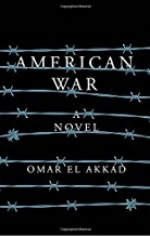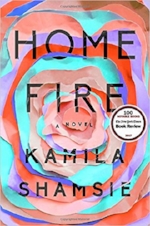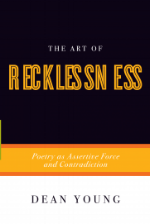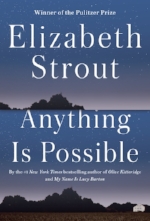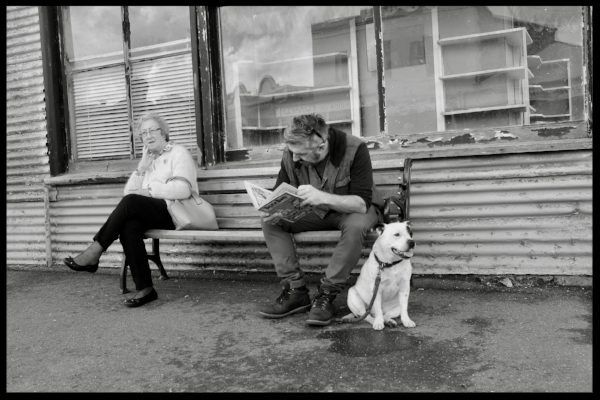If your 2017 was anything like ours, it whizzed by in a dizzy of confused haste. That's one of the reasons our round-up of the best of 2017 is a bit delayed. But the books that crossed our paths in the previous twelve months were too good to ignore. As usual, we asked some of our favorite literary people to tell us what stood out in their reading year, regardless of the book's publication date. We also asked them to give us a peek at what they're looking forward to in 2018.
ANDRÉS HAX
In such a fraught and desperate year—the year of American carnage—it is tempting to cite a solemn and ponderous book as one’s favorite of 2017. Hannah Arendt’s The Origins of Totalitarianism, for example, or Svetlana Alexievich’s Secondhand Time. But I will be honest. The book published in 2017 that most astounded and delighted me, and that I am sure will accompany me for many years to come, was Legendary Authors and the Clothes They Wore by Terry Newman. Do yourself a favor and get a copy immediately. You can probably still score a first edition.
When I heard about Newman´s book I thought, finally! And upon reading and rereading it, my admiration only increases. Terry Newman is an Englishwoman who has worked in the fashion industry for more than twenty-five years. Her book—which has the look and feel of the Year Book of the coolest people on Earth—profiles the clothing of forty-nine writers, from Samuel Beckett and Edith Sitwell to Karl Ove Knausgaard and Zadie Smith, from Joe Orton and Cornel West to Toni Morrison and Simone de Beauvoir.
I could say so many things about this book, but to boil it down to a point: Terry Newman says and demonstrates something that we all knew was true but no one dared say. Writers are no different from musicians, actors and painters. Cool counts. Cool defines. Cool is the goal. But, also, cool is cool. You can’t fake it or copy it. You can’t aspire to it or fabricate it. You have it or you don’t. And the best have it. And if you don’t got it, you never will. It’s like the feel of your skin or the taste of your mouth. Coming back down to earth…
I don’t know about you, but when literature and the world of writers exploded in my mind—in my otherwise forgettable adolescence—my bedroom walls were soon emblazoned with elegant black and white postcards of Albert Camus, Hemingway, Kafka, Virginia Woolf, Proust and on and on. I was as impressed by The Stranger as by the writer’s black trench coat with the collar menacingly upturned. When I fell in love with James Joyce’s mind-altering prose, his dashing figure was always hovering in my field of vision, as if between the text and me. And on and on.
This book is brilliant: visually (it is chock-full of photographs and quotes in pleasing typewriter-like fonts); in its thematic organization (Glasses, Suits, Hair, Hats, etcetera) and in its content. Although it is written with a light touch, it is by no means frivolous. Furthermore, it is the best type of book for a book-fiend. The kind that fills you with yearning to return to favorite authors and to read, finally, writers who you know of very well but in fact have not ever read.
As a final point of praise, I will add that it is always a great relief (although it is a rare event) to read someone who writes about literature and writing who is not in the business. There is no envy, greed, speculation, self-pity or ego in the text. It is pure joy.
Most Looking Forward to in Early 2018:
As for what book I am most looking forward to in this new year, I will be eagerly awaiting any new prose by Patti Smith. In fact, I would implore her to just keep bestowing us with one new book a year to add to Just Kids and M Train. In these truly dark times of ecological dread, political despair and media addiction, her writing is an inspiration to live and work with clarity and love. To not be afraid. To go forward. To sing, to write, to photograph, to read and read and read, to drink coffee in cafes with pen and paper in hand (in the old style!), to turn off the telephone and live in the moment which is—despite all news to the contrary—a miracle. Literally.
Andrés Hax is a cultural reporter based in Buenos Aires.
JENNIFER LEVASSEUR
First, a caveat: 2017 became the most broken, erratic and difficult reading year I’ve experienced. For the first time, I couldn’t concentrate or finish books. Anyone who’s dealt with extreme change and grief understands that sometimes when we most need the escape of books, we can’t move far enough outside ourselves to let them do their work. How did I finally escape this pit of not-reading? I forced myself to read seven books in a week, in a kind of fake-it-until-it-feels-right move. I had my doubts, but it worked. Now I’m thrilled about the plethora of exciting titles we have to look forward to in 2018 (stay tuned for our list of the books you’ll want to read in the first six months of the year). Now, back to 2017.
Killers of the Flower Moon: The Osage Murders and the Birth of the FBI by David Grann
A heavily researched page-turner about the serial murders of Osage in the 1920s. The Osage, through mineral and oil rights, found themselves among the wealthiest people on earth. Then they began to die in mysterious and gruesome ways. Grann writes with compassion, precision and heart.
Stay with Me by Ayobami Adebayo
When Yejide and Akin fall in love, they agree that they will remain exclusive; Akin will not take multiple wives. But years into their marriage, there is no child. When Yejide’s in-laws show up at their home with a young woman and introduce her as Akin’s second wife, her husband will not meet her eyes. They are both heartbroken, but their devotion may not be enough to push aside familial and cultural demands. As their lives progress, they’re forced to keep more secrets from each other. Adebayo writes with delicate attention to the interior lives we dare not share with others.
Manhattan Beach by Jennifer Egan
The first historical novel by the author of A Visit from the Goon Squad is sharp and snappy. A seemingly dedicated father walks away from his family in the aftermath of the Great Crash. His daughter must provide for her mother and disabled sister by going to work for the war effort. Dialogue reminiscent of the best 1940s cinema.
The Ninth Hour by Alice McDermott
A few years ago, I raved about McDermott’s quietly beautiful Someone. Years before that, I discovered her, along with scores of other readers, when she won the National Book Award for Charming Billy. How had she not already been a household name? The Ninth Hour returns to a typical McDermott subject, Irish immigrants in New York struggling to make a home and to reconcile their inner lives with their circumstances. The novel opens as a man gases himself in his apartment, leaving behind a young, pregnant wife. Irish nuns sweep in to comfort the widow, quell the whispers about how her husband died and give her a new reality. Told from the perspective of children of the next generation, The Ninth Hour provides a somehow gentle yet unflinching look at how each decision refracts, how chance can form lives, but that the most deliberate actions tell us who we are.
American War by Omar El Akkad
A terrifying but thrilling adventure story about how climate change could flip the entire world order. The Gulf of Mexico is now the Sea of Mexico, much of the South no longer exists, terror reigns. At heart, it’s the story of an ordinary family that tries to stay out of politics but is pulled into choosing sides. A wonderful debut by a Cairo-born journalist.
My Absolute Darling by Gabriel Tallent
This novel wins the award for best book of 2017 that I did not want to read. When I heard the book described—a survivalist who controls every aspect of his fourteen-year-old daughter’s life through an alarming mix of manipulation and devotion—I decided I’d not only already read versions of this story but that it no longer interested me. Well, My Absolute Darling was a wake-up call against comfortable, split decisions about what I think I know. Gabriel Tallent does it all in this debut, providing rich characters that erupt from the page fully formed, creating descriptions of place that zing and challenge, balancing the horrific with the laugh-out-loud funny, writing with such pace and fury that I had to put the book down at times just to still my heart-thumping anxiety. The last third of the book almost did me in—in the best possible way. For fans of fast-paced literary fiction unafraid of psychological terror. I finished the 400+ pages in two sittings.
Home Fire by Kamila Shamsie
A heartbreaking contemporary retelling of Antigone set in London, New York and Pakistan. Shamsie is a ferocious writer, one who never accepts easy judgments about people or events. This is a love story coupled with political implications, family secrets and the truth about what power can buy.
I also loved Charlotte by David Foenkinos, a retelling of the troubled life of artist Charlotte Salomon, and Anything Is Possible by Elizabeth Strout.
Most Looking Forward to in Early 2018:
Amy Bloom's White Houses.
I just started reading Amy Bloom’s forthcoming (February) novel White Houses, told from the point of view of the woman Eleanor Roosevelt loved. Like her previous novel, Lucky Us, Bloom combines the breezy with the scandalous. It’s a warm book that channels the period and these two very different women effortlessly.
MICHAEL MARTIN
2017—Year of The Unibrow
A few months ago, I was riding around town in the mini-van with my younger son. He was situated in the back seat behind me and was alarmingly quiet, just gazing out the side window. I’d periodically take a peak in the rear-view mirror, tempted to ask him what was on his mind. But I kept my mouth shut. We drove for miles and the boy didn’t say a word. Didn’t move. Something had gotten hold of his mind; he was chewing on some mystical concern maybe, perhaps perplexed at the godless world unspooling out his window. I sensed the boy would soon break his silence and give something up. Something big. This might be intense, I thought. This might be good. We finally stopped at a light and I glanced in the rearview mirror and watched him as he slowly turned away from his window. “Pops,” my son said. “Do you know anyone with a unibrow?”
I should know by now that one mustn’t expect profundity or deep insight from children. Or poets. Leave it to others to shape the world and its sensations into some knowable, solid cast. This past year I reread poet Dean Young’s short book on poetry called The Art of Recklessness, and the entire book, discursive and associative, just like his poetry, drives home that point. The book is unsettling, invigorating and fully antithetical to any “How To” book. “The writing of poetry is not a craft,” Young says adamantly, and he doesn’t put high value on precious or competent poetry either. In Young’s Recklessness, a poem derives its power from the imagination and surprise; if there’s anything knowable in a poem, it will be fleeting and “almost” articulated. A poem is written, “So that the meaning can begin, and doing so be undone,” Young quotes John Ashbery. It’s no surprise that Young finds his lodestars in the French surrealists and abstract expressionists, in jazz music, the primitive and the tension that humor affords in language. “The highest accomplishment of human consciousness is the imagination,” Young writes in Recklessness, “and the highest accomplishment of the imagination is empathy and love.” This isn’t profound because it doesn’t ask for much deep thought. Like Young’s book, it just feels like another fact of an imaginary heart.
A painter friend of mine is crazy about John Ashbery’s work and lent me Ashbery’s Other Traditions. It’s not poetry, but a collection of six Ashbery lectures he presented at Harvard over the decades, bound up in a lovely book. It’s essentially Ashbery gathering together six poets who’ve left a footprint on his work. They may be obscure poets—John Clare, Thomas Lovell Beddoes, Raymond Roussel, John Wheelwright, Laura Riding, and David Schubert—but in Ashbery’s orbit they certainly aren’t minor, especially Riding. In granular precision, Ashbery details the importance they had in the development of his own voice and aesthetic, but it’s only in Laura Riding’s associative wilder poems that we hear and see an obvious correlation.
The Poems of Laura Riding was published in 1938. Then in her thirties, Riding—a born and bred New Yorker—announced her “retirement” from poetry. Her career had been international, laudatory and abbreviated. Paul Auster once wrote, “At an age when most poets are just coming into their own, she (Riding) had already reached maturity.” Mature artist or not, she was finished. She married a fellow named Jackson, bought an eleven-acre citrus grove in Central Florida and lived in a dilapidated cracker house until her death, writing and editing dictionaries. She was a haughty thing—she wrote her name as, “Laura (Riding) Jackson”—and yes, the "Riding" part she smashed between parentheses. Riding let everyone know before her self-imposed exile that, “Poetry was dead,” (whatever that meant) and quietly disappeared.
I carried The Poems of Laura Riding around with me almost all of last year. In the sauna, the gym, the car, the doctor; it’s all mangled up and melting away. Her poetry aches for something certain, which is perhaps why she left poetry for something more definite, like dictionaries.
Riding often sounds like her contemporary, Samuel Beckett, though I doubt they ever met. This, the first few lines of “Advertisement”:
I say myself.
The beginning was that no saying was.
There was no beginning.
There is an end and there was no beginning.
Her poems are deeply compressed. The beginning of “The Wind Suffers”:
The wind suffers from blowing,
The sea suffers of water,
And fire suffers of burning,
And I of a living name.
As stone suffers of stoniness,
As light of its shiningness,
As birds of the wingedness,
So I of my whoness.
Like Beckett and Dickinson and Ashbery, if there’s a tenderness in Riding’s poems, it’s the tenderness of thought, the tenderness of uncertainty.
Most Looking Forward to in Early 2018:
As for 2018, Kenneth Lonergan’s film Margaret (2011) will be re-released this year as a director’s cut, which is something to look forward to. Many filmgoers might have found their way to Margaret after Lonergan’s recent film, Manchester By The Sea. When I first saw Margaret, I immediately saw it again; it was that compelling. I also know that Marilynne Robinson has a collection of essays, What Are We Doing Here?, being published next month, which is something I’ll find and read.
Michael Martin is a poet, playwright and editor.
DANIEL STEPHENSEN
Reunion by Fred Uhlman
A brief, utterly compelling novella, Reunion tells the story of the friendship between two German schoolboys in Stuttgart just before World War II. Hans is Jewish, and Konradin is the son of aristocrats. The boys’ intense meeting of minds is complicated and doomed by the insidious anti-Semitism set free in Germany by the rise of the Nazi party, anti-Semitism openly practiced by Konradin’s parents and by teachers at the school. Uhlman’s prose (he wrote Reunion in English) is extraordinarily concise and penetrating: “My mother was too busy to bother about Nazis, Communists and other such unpleasant people, and if my father had no doubts that he was a German, my mother if possible, had even fewer. It simply didn’t enter her head that any sane human being could question her right to live and to die in this country.” Uhlman shows inherited prejudices steadily developing into committed racist action in the hearts and minds of neighbors, a picture of subtle ethical degradation that I find particularly relevant.
Terra Nullius by Claire G. Coleman
Terra Nullius is my introduction to indigenous Australian science fiction. It is about the devastating impact of settlement on the indigenous Australian population, and it reads, especially in the first part of the novel, like an adventure story. Young indigenous slave Jacky escapes from brutal settlers, and the novel allows for a reading in which this escape is a hero’s journey. My habit was blindly to accept this, which only shows how ignorant I am. Why have I become so infected by the idea of life as a journey? It is stupefying. Jacky isn’t journeying—even when he sets out in search of an origin he only vaguely remembers; he’s chiefly trying not to die. (I was reminded of Brian Aldiss’s novel Hothouse, in which the characters do not seek or journey; they just go until they die or manage not to die. If they survive, they try to make meaning with what they have left.) My first reading of Terra Nullius involved trying to settle the novel by invading it with my Anglo literary history. I now think this is the resistant reading. To read with this novel is to expose oneself to a lucid and incredibly clever polemic against the anti-indigenous racism of the status quo in Australian politics and culture. White settlement in Australia, this appalling erasure, is still going on. Nothing about Terra Nullius is a trick or a game; it is simply that Coleman starts with a familiar-enough story, and then takes away the familiarity until the memory of it remains. Soon enough, even that is lost. Now we have to learn to read differently, to see the formerly familiar world differently, and to make meaning in new ways.
Light of the World by James Lee Burke
James Lee Burke’s twentieth novel starring detective Dave Robicheaux was going to be a kind of comfort read for me: Burke’s familiar style, my favorite characters, stories of good versus evil, plenty of mayhem but the good guys winning in the end... Only, the evil in this novel is so evil, so relentlessly bad, that my nerves were in turmoil! Not so comforting, but of course I loved it. Dave Robicheaux, on holiday in Montana, receives word that the horrifying serial killer Asa Surrette (for me, this is Burke’s most haunting villain) has escaped from a prison transport passing through the state. Robicheaux is convinced Surrette is hunting his daughter, Alafair, who wrote a damning article about unsolved crimes for which Surrette may be responsible. The authorities are corrupt, the system is dirty, and Robicheaux and his old partner Clete Purcell take matters into their own hands. Burke is one of the greats, in any genre, and his writing is as excellent as ever, a great comfort in itself.
Most Looking Forward to in Early 2018:
Robicheaux by James Lee Burke (January 2018)
Agency by William Gibson (April 2018)
Room to Dream by David Lynch and Kristine McKenna (June 2018)
Warlight by Michael Ondaatje (May 2018)
Daniel Stephensen is Contributing Editor of Sacred Trespasses.
IAN & MAUREEN THOMPSON
Selecting favorite books from a year’s reading is a little like answering the question Which of your children do you most love? Each book brings its individual delights or disappointments, and 2017 had plenty of both.
One favorite was The Last Painting of Sara De Vos by Australian writer Dominic Smith. Three stories and times intersect—a finely drawn portrait of a renowned woman painter of seventeenth-century Holland, an Australian student in New York in the 1950s and the consequences of her youthful mistake for her present-day career in Sydney. It is a beautiful novel which leaves the reader ambivalent about authenticity in art and life.
Elizabeth Strout’s Anything is Possible is a companion piece to last year’s My Name is Lucy Barton. Anything is Possible reveals tender but shrewd insights into life in the hometown of Lucy Barton, successful New York writer. Strout explores family bonds, the reverse snobbery of those who stayed behind and the complexities of old and new friendships. Elizabeth Strout knows well the point at which laughter trips itself into sobbing.
As a long-time lover of Henry James, it was with trepidation that I opened John Banville’s Mrs Osmond. Why not just read more Henry? However, this novel, which follows the fate of Isabel Osmond after the conclusion of James’s Portrait of a Lady, is a hoot! For some readers, the style of “phony Henry James” might be off-putting, but I loved the account of Isabel’s gradual progress toward her sweet revenge on Madame Merle and Gilbert Osmond. I wanted to wave my arms and cheer!
A reading year wouldn’t be satisfying without a Willa Cather or two. A Barnes and Noble Classics edition of O Pioneers! and a very attractive reprint of Willa Cather in Europe: Her Own Story of the First Journey were a treat.
In the Night of Time by Antonio Muñoz Molina tells of a passionate love affair between a married middle-aged Spanish architect and a British woman during the early years of the already brutal and bloody Spanish Civil War.
Ignacio Abel is desperate to escape the confines of the narrow conservative mores of his wife’s family and to pursue his lover; all this within a heightened sense of fear and the moral collapse of Spanish society.
The Golden Legend by Nadeem Aslam is set in Pakistan during the conflict with India over Kashmir. It portrays a society terrorized by corrupt military driven by religious extremism, through the relationships of a young Christian woman and a displaced young Kashmiri who are supported by the recently widowed Nargis who hides her own dangerous secret. Hope and tender love tenuously weave through this poignant and beautifully crafted story.
Nicole Krauss’s History of Love is hilarious and tragic; A Grace Paley Reader provides a view into her versatility as a writer of short stories, poetry and essays. Steven Carroll’s A New England Affair gives us insight into the romantic nature of the publically austere T. S. Eliot; My Absolute Darling by Gabriel Tallent has a story and a hero not easily forgotten.
Most Looking Forward to in Early 2018:
We are waiting patiently for Hilary Mantel to finish her third in the Wolf Hall trilogy. The two previous novels are brilliant and we suspect Mantel can’t bring herself to kill off Tom, which would be unavoidable! We hope 2018 will see the third book.
Also looking forward to Julian Barnes’s The Only Story and a recommendation from family in the US, the Claire DeWitt novels by Sara Gran.
We will try not to read about U.S. politics in 2018.
Ian and Maureen Thompson are both retired from careers in economics and education/ethics respectively. Ian is a Beckett enthusiast, and Maureen has a long-time relationship with Henry James. They live in Melbourne and visit Washington, D.C., frequently.
REGGIE SCOTT YOUNG
The Last Ballad by Wiley Cash
The book that meant the most to me last year was Wiley Cash’s novel The Last Ballad, although for partially selfish reasons. Cash was a graduate student of mine at the University of Louisiana at Lafayette a little more than a decade ago and I directed his dissertation in creative writing. The novel he wrote for his degree was published as the bestselling A Land More Kind Than Home in 2012. The story grew out of a handout he received in one of my classes about a church healing service that went awry in a rural Illinois community and resulted in the death of a young child, although the novel he produced focuses on a child’s murder during a religious ritual performed under the direction of a sinister preacher in the mountains of Cash’s native state of North Carolina. He followed it with This Dark Road to Mercy, about an estranged father, a former minor league baseball player, who kidnaps his two baseball-loving daughters with a large stash of cash stolen from a mobster in his possession. With a vicious hit man on their trail followed by the girls’ guardian ad litem, the characters all end up in St. Louis’s Busch Stadium on the day when Mark McGwire attempts to break baseball’s all-time home run record.
The Last Ballad is a very different novel, although it is clearly written by the hand of the same writer. For one, it is mainly told through third-person narration as opposed to multiple first-person storytellers, the narrative device Cash used in his first two novels. Furthermore, the story focuses on a historical figure, Ella May Watkins, a poor mill worker, folk singer and mother of five who becomes a leading labor organizer and advocate for racial equality before her assassination by anti-union forces during North Carolina’s historic mill-worker strike in 1929. As a graduate student, Cash made his love of his native state apparent to anyone he came into contact with as well as his goal of becoming a prominent North Carolina author, something he quickly achieved. The title of the first novel may suggest an idealized fascination with the American “Tar Heel” state, but the darkness implied in the title of the second characterizes the climate of each, with The Last Ballad serving as the darkest of the three despite the redemptive possibilities suggested by the novel’s only first-person narrator, Wiggins’ elderly daughter, Lilly, who offers insights about the mother who was taken from her during her early childhood and the aftermath of her death through epistles written to one of her nephews.
As a youth in Gastonia, Cash worked as a lifeguard in a country club frequented by descendants of the old mill owning families he wrote about in the novel. Although he was aware of the differences between his and their backgrounds, the experience helped him to offer balanced and in depth portrayals of characters both rich and poor. Early in the novel, Lilly Wiggins mentions to her nephew Look Homeward, Angel, the most famous novel by North Carolina’s most important writer, Thomas Wolfe, and quotes a line from the book that states, “Which of us is not forever a stranger and alone.” Among Cash’s goals in writing The Last Ballad was to rescue Ella May Wiggins’ legacy from obscurity by making her story a familiar one. In the midst of the current “Me Too” movement in the United States and other parts of the world that seeks, in part, to pay tribute to heroic women from both the present and past, this story about a poor mother who loses her life in a struggle for equality and human dignity is a fascinating read, despite the fact that it was written by a male author.
Most Looking Forward to in Early 2018:
The book I’m most looking forward to reading this year is Heads of the Colored People: Stories by Nafissa Thompson-Spires (April). There is an old blues expression that says: “You have to laugh to keep from crying,” one used by both Langston Hughes and Tyler Perry as titles of their own works. But since the election of Barack Obama in 2008 and the declaration by many of a new post-racial age in the United States, racial divisions have grown so sharply that the current president can call white supremacists “very fine people” and declare predominately black countries to be “s**t-holes,” with a large segment of the American population defending the legitimacy of his words. Heads of the Colored People promises to address the question of how it feels to be a black American in times such as these. It will be interesting to see if the humor of Thompson-Spires’s stories will offer the kind of solace that many people sought to find in blues music during much harsher times in American history.
Reggie Scott Young is the author of Yardbirds Squawking at the Moon. His works of poetry, fiction and nonfiction have appeared in Fifth Wednesday Journal, Louisiana Literature, The Oxford American and other publications.
Clunes Booktown, 2016. Photo: Kevin Rabalais.









